Decadal Scale Variability of Larsen Ice Shelf Melt Captured by Antarctic Peninsula Ice Core
Abstract
1. Introduction
2. Materials and Methods
2.1. Drill Site
2.2. Water Stable-Isotopes
2.3. Reanalysis Data
2.4. RACMO Data
2.5. Computational Procedure
3. Results
3.1. Decadal Scale Climate Variability
3.2. Ice Shelf Surface Melt Linked to IPO Positive Phase (1979–1998)
3.3. Less Melt-Prone Conditions during the 1999–2011 IPO Negative Phase
4. Discussions
5. Conclusions
Author Contributions
Funding
Institutional Review Board Statement
Informed Consent Statement
Data Availability Statement
Acknowledgments
Conflicts of Interest
References
- Rignot, E.; Bamber, J.L.; van den Broeke, M.R.; Davis, C.; Li, Y.; van de Berg, W.J.; van Meijgaard, E. Recent Antarctic Ice Mass Loss from Radar Interferometry and Regional Climate Modelling. Nat. Geosci. 2008, 1, 106–110. [Google Scholar] [CrossRef]
- Rott, H.; Skvarca, P.; Nagler, T. Rapid Collapse of Northern Larsen Ice Shelf, Antarctica. Science 1996, 271, 788–792. [Google Scholar] [CrossRef]
- Rack, W.; Rott, H. Pattern of Retreat and Disintegration of the Larsen B Ice Shelf, Antarctic Peninsula. Ann. Glaciol. 2004, 39, 505–510. [Google Scholar] [CrossRef]
- Scambos, T.A.; Bohlander, J.A.; Shuman, C.A.; Skvarca, P. Glacier Acceleration and Thinning after Ice Shelf Collapse in the Larsen B Embayment, Antarctica. Geophys. Res. Lett. 2004, 31, L18402. [Google Scholar] [CrossRef]
- Fogt, R.L.; Marshall, G.J. The Southern Annular Mode: Variability, Trends, and Climate Impacts across the Southern Hemisphere. WIREs Clim. Chang. 2020, 11, e652. [Google Scholar] [CrossRef]
- Kuipers Munneke, P.; Luckman, A.J.; Bevan, S.L.; Smeets, C.J.P.P.; Gilbert, E.; van den Broeke, M.R.; Wang, W.; Zender, C.; Hubbard, B.; Ashmore, D.; et al. Intense Winter Surface Melt on an Antarctic Ice Shelf. Geophys. Res. Lett. 2018, 45, 7615–7623. [Google Scholar] [CrossRef]
- Luckman, A.; Elvidge, A.; Jansen, D.; Kulessa, B.; Kuipers Munneke, P.; King, J.; Barrand, N.E. Surface Melt and Ponding on Larsen C Ice Shelf and the Impact of Föhn Winds. Antarct. Sci. 2014, 26, 625–635. [Google Scholar] [CrossRef]
- England, M.H.; McGregor, S.; Spence, P.; Meehl, G.A.; Timmermann, A.; Cai, W.; Gupta, A.S.; McPhaden, M.J.; Purich, A.; Santoso, A. Recent Intensification of Wind-Driven Circulation in the Pacific and the Ongoing Warming Hiatus. Nat. Clim. Chang. 2014, 4, 222–227. [Google Scholar] [CrossRef]
- Fyfe, J.C.; Meehl, G.A.; England, M.H.; Mann, M.E.; Santer, B.D.; Flato, G.M.; Hawkins, E.; Gillett, N.P.; Xie, S.-P.; Kosaka, Y.; et al. Making Sense of the Early-2000s Warming Slowdown. Nat. Clim. Chang. 2016, 6, 224–228. [Google Scholar] [CrossRef]
- Meehl, G.A.; Arblaster, J.M.; Bitz, C.M.; Chung, C.T.Y.; Teng, H. Antarctic Sea-Ice Expansion between 2000 and 2014 Driven by Tropical Pacific Decadal Climate Variability. Nat. Geosci. 2016, 9, 590–595. [Google Scholar] [CrossRef]
- Abram, N.J.; Wright, N.M.; Ellis, B.; Dixon, B.C.; Wurtzel, J.B.; England, M.H.; Ummenhofer, C.C.; Philibosian, B.; Cahyarini, S.Y.; Yu, T.-L.; et al. Coupling of Indo-Pacific Climate Variability over the Last Millennium. Nature 2020, 579, 385–392. [Google Scholar] [CrossRef] [PubMed]
- Bromwich, D.H.; Rogers, A.N.; Kållberg, P.; Cullather, R.I.; White, J.W.C.; Kreutz, K.J. ECMWF Analyses and Reanalyses Depiction of ENSO Signal in Antarctic Precipitation. J. Clim. 2000, 13, 1406–1420. [Google Scholar] [CrossRef]
- Okumura, Y.M.; Schneider, D.; Deser, C.; Wilson, R. Decadal–Interdecadal Climate Variability over Antarctica and Linkages to the Tropics: Analysis of Ice Core, Instrumental, and Tropical Proxy Data. J. Clim. 2012, 25, 7421–7441. [Google Scholar] [CrossRef]
- Goodwin, B.P.; Mosley-Thompson, E.; Wilson, A.B.; Porter, S.E.; Sierra-Hernandez, M.R. Accumulation Variability in the Antarctic Peninsula: The Role of Large-Scale Atmospheric Oscillations and Their Interactions. J. Clim. 2016, 29, 2579–2596. [Google Scholar] [CrossRef]
- Porter, S.E.; Parkinson, C.L.; Mosley-Thompson, E. Bellingshausen Sea Ice Extent Recorded in an Antarctic Peninsula Ice Core. J. Geophys. Res. Atmos. 2016, 121, 13813–13900. [Google Scholar] [CrossRef]
- Emanuelsson, B.D.; Thomas, E.R.; Tetzner, D.R.; Humby, J.D.; Vladimirova, D.O. Ice Core Chronologies from the Antarctic Peninsula: The Palmer, Jurassic, and Rendezvous Age-Scales. Geosciences 2022, 12, 87. [Google Scholar] [CrossRef]
- Keller, E.D.; Baisden, W.T.; Bertler, N.A.N.; Emanuelsson, B.D.; Canessa, S.; Phillips, A. Calculating Uncertainty for the RICE Ice Core Continuous Flow Analysis Water Isotope Record. Atmos. Meas. Tech. Discuss. 2018, 2018, 1–20. [Google Scholar] [CrossRef]
- Gkinis, V.; Popp, T.J.; Blunier, T.; Bigler, M.; Schüpbach, S.; Kettner, E.; Johnsen, S.J. Water Isotopic Ratios from a Continuously Melted Ice Core Sample. Atmos. Meas. Tech. 2011, 4, 2531–2542. [Google Scholar] [CrossRef]
- Emanuelsson, B.D.; Baisden, W.T.; Bertler, N.A.N.; Keller, E.D.; Gkinis, V. High-Resolution Continuous-Flow Analysis Setup for Water Isotopic Measurement from Ice Cores Using Laser Spectroscopy. Atmos. Meas. Tech. 2015, 8, 2869–2883. [Google Scholar] [CrossRef]
- Jones, T.R.; White, J.W.C.; Steig, E.J.; Vaughn, B.H.; Morris, V.; Gkinis, V.; Markle, B.R.; Schoenemann, S.W. Improved Methodologies for Continuous-Flow Analysis of Stable Water Isotopes in Ice Cores. Atmos. Meas. Tech. 2017, 10, 617–632. [Google Scholar] [CrossRef]
- Maselli, O.J.; Fritzsche, D.; Layman, L.; McConnell, J.R.; Meyer, H. Comparison of Water Isotope-Ratio Determinations Using Two Cavity Ring-down Instruments and Classical Mass Spectrometry in Continuous Ice-Core Analysis. Isotopes Environ. Health Stud. 2013, 49, 387–398. [Google Scholar] [CrossRef] [PubMed]
- Hersbach, H.; Bell, B.; Berrisford, P.; Hirahara, S.; Horányi, A.; Muñoz-Sabater, J.; Nicolas, J.; Peubey, C.; Radu, R.; Schepers, D.; et al. The ERA5 global reanalysis. Q. J. R. Meteorol. Soc. 2020, 146, 1999–2049. [Google Scholar] [CrossRef]
- Cavalieri, D.J.; Gloersen, P.; Campbell, W.J. Determination of Sea Ice Parameters with the NIMBUS 7 SMMR. J. Geophys. Res. Atmos. 1984, 89, 5355–5369. [Google Scholar] [CrossRef]
- van Wessem, J.M.; van de Berg, W.J.; Noël, B.P.Y.; van Meijgaard, E.; Amory, C.; Birnbaum, G.; Jakobs, C.L.; Krüger, K.; Lenaerts, J.T.M.; Lhermitte, S.; et al. Modelling the Climate and Surface Mass Balance of Polar Ice Sheets Using RACMO2–Part 2: Antarctica (1979–2016). Cryosphere 2018, 12, 1479–1498. [Google Scholar] [CrossRef]
- Lenaerts, J.T.M.; Medley, B.; van den Broeke, M.R.; Wouters, B. Observing and Modeling Ice Sheet Surface Mass Balance. Rev. Geophys. 2019, 57, 376–420. [Google Scholar] [CrossRef]
- Bretherton, C.S.; Widmann, M.; Dymnikov, V.P.; Wallace, J.M.; Blade, I. Effective Number of Degrees of Freedom of a Spatial Field. J. Clim. 1999, 12, 1990–2009. [Google Scholar] [CrossRef]
- Thoma, M.; Jenkins, A.; Holland, D.; Jacobs, S. Modelling Circumpolar Deep Water Intrusions on the Amundsen Sea Continental Shelf, Antarctica. Geophys. Res. Lett. 2008, 35, 1–6. [Google Scholar] [CrossRef]
- Holland, P.R.; Brisbourne, A.; Corr, H.F.J.; McGrath, D.; Purdon, K.; Paden, J.; Fricker, H.A.; Paolo, F.S.; Fleming, A.H. Oceanic and Atmospheric Forcing of Larsen C Ice-Shelf Thinning. Cryosphere 2015, 9, 1005–1024. [Google Scholar] [CrossRef]
- Paolo, F.S.; Fricker, H.A.; Laurie, P. Volume Loss from Antarctic Ice Shelves Is Accelerating. Science 2015, 348, 327–331. [Google Scholar] [CrossRef]
- Miller, R.L.; Schmidt, G.A.; Shindell, D.T. Forced Annular Variations in the 20th Century Intergovernmental Panel on Climate Change Fourth Assessment Report Models. J. Geophys. Res. Atmos. 2006, 111, D18101. [Google Scholar] [CrossRef]
- Simpkins, G.R.; Karpechko, A.Y.; Miller, R.L.; Schmidt, G.A.; Shindell, D.T. Sensitivity of the Southern Annular Mode to Greenhouse Gas Emission Scenarios. Clim. Dyn. 2012, 38, 563–572. [Google Scholar] [CrossRef]
- Emanuelsson, B.D.; Thomas, E.R.; Humby, J.D.; Vladimirova, D.O. Water-Stable Lsotope (D18O, DD), Sodium (23Na), and Magnesium (24Mg) Continuous Flow Analysis Data for the Palmer Ice Core, Palmer Land, Antarctic Peninsula, 1621–2011 C.E.; Version 1; NERC EDS UK Polar Data Center: Cambridge, UK, 2022. [Google Scholar] [CrossRef]
- Emanuelsson, B.D.; Humby, J.D.; Tetzner, D.R.; Thomas, E.R.; Vladimirova, D.O. Ages Scales for the Palmer, Jurassic, and Rendezvous Antarctic Peninsula Ice Cores (Version 1.0) [Data Set]; NERC EDS UK Polar Data Center: Cambridge, UK, 2022. [Google Scholar] [CrossRef]
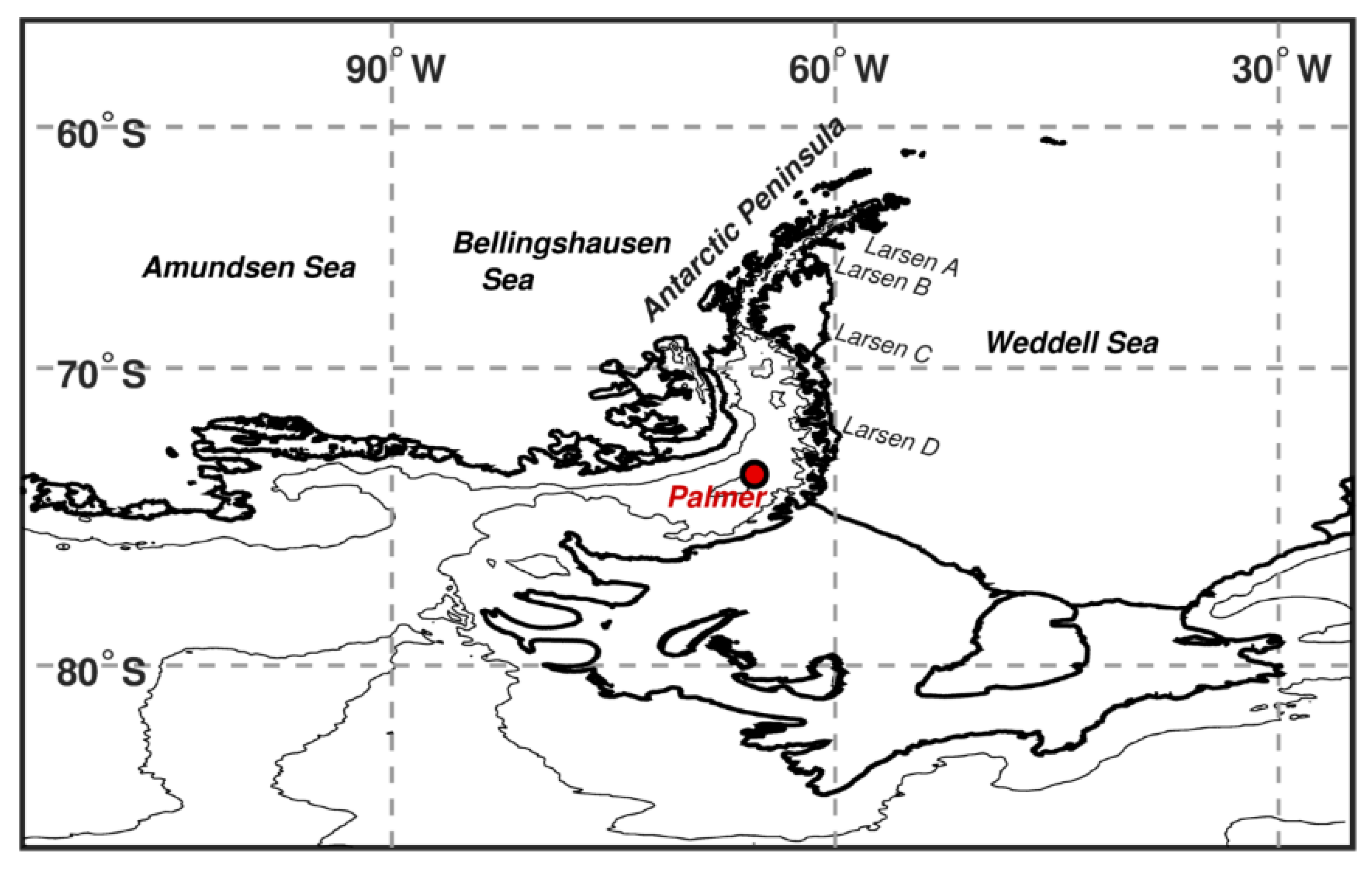
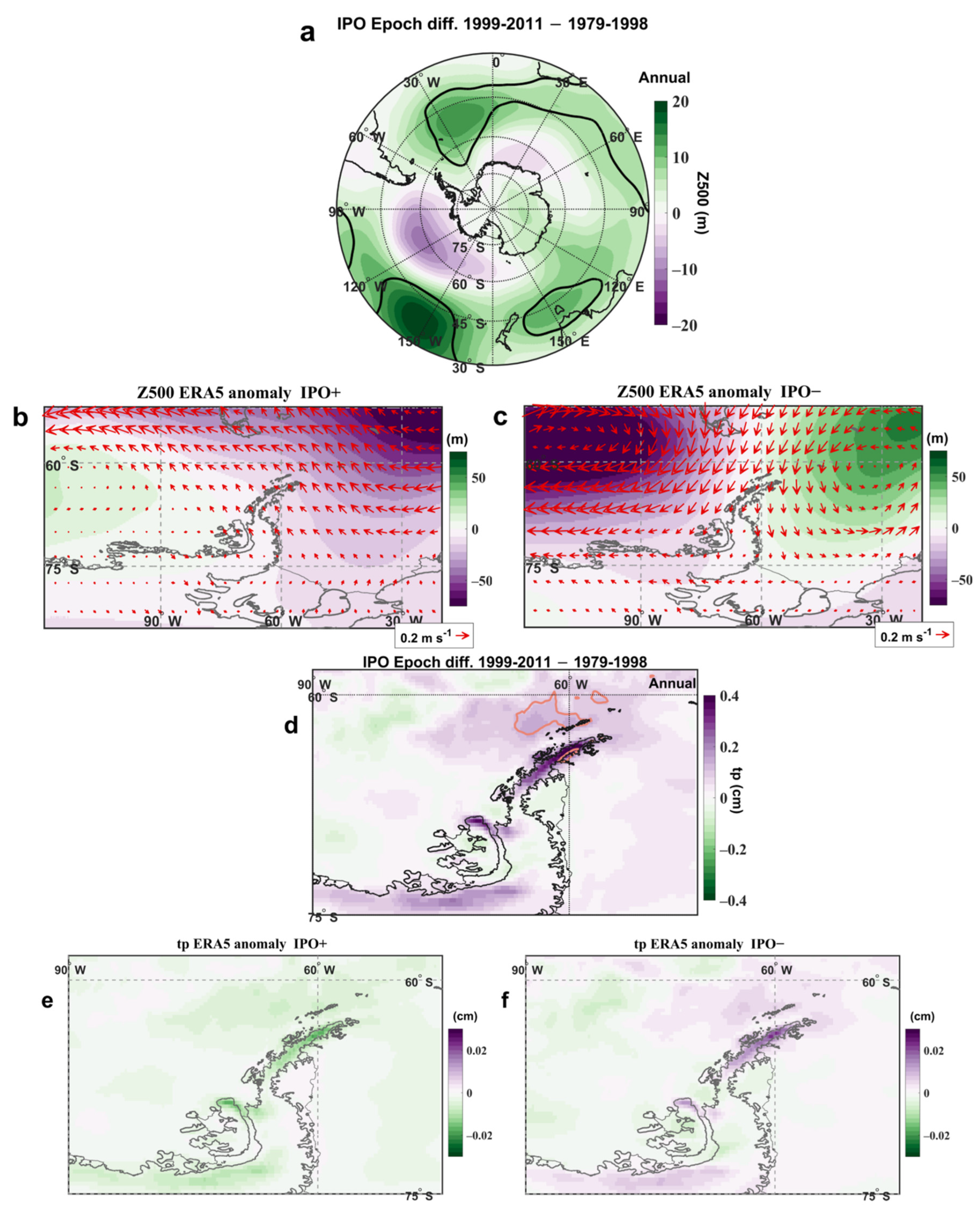
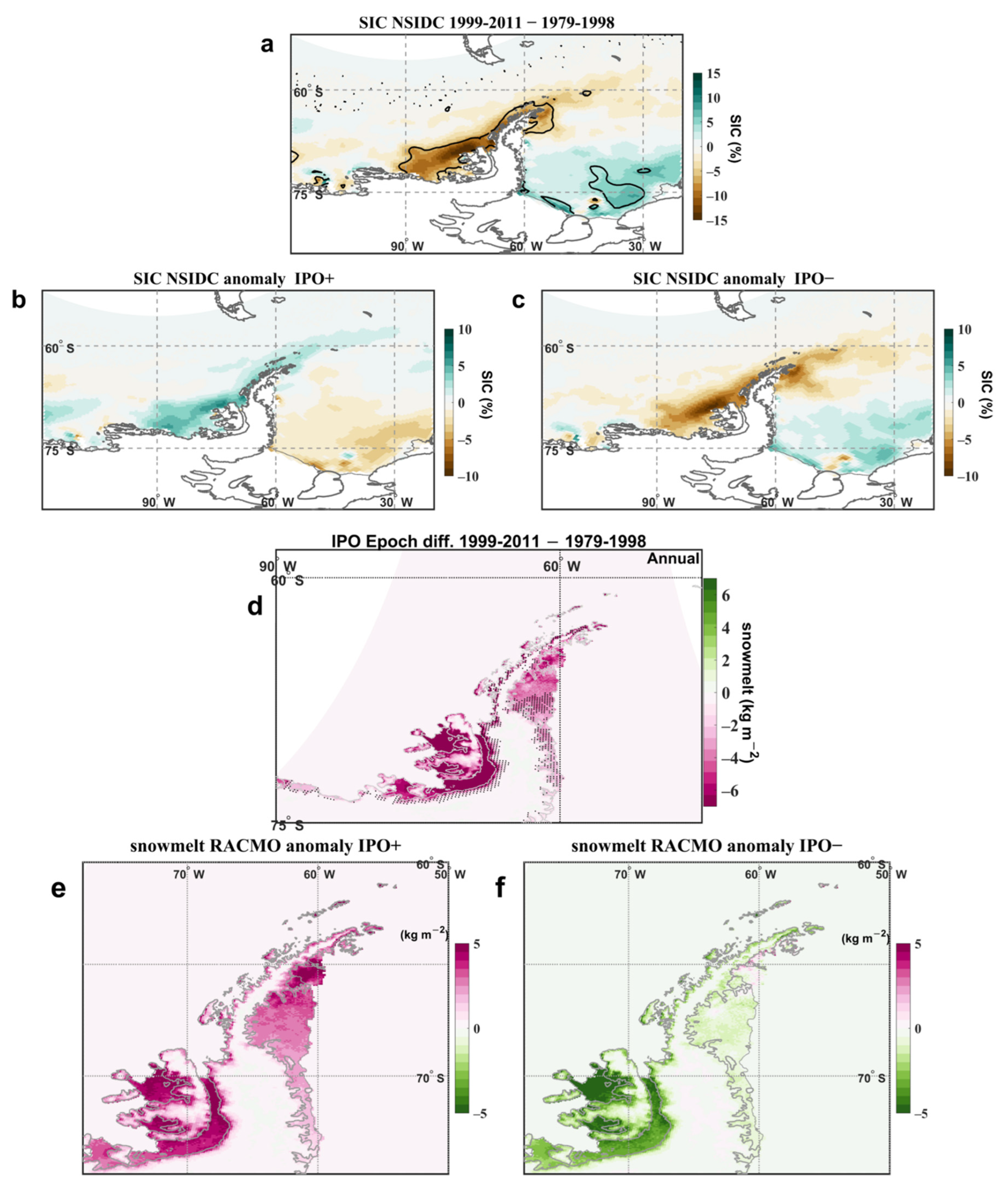
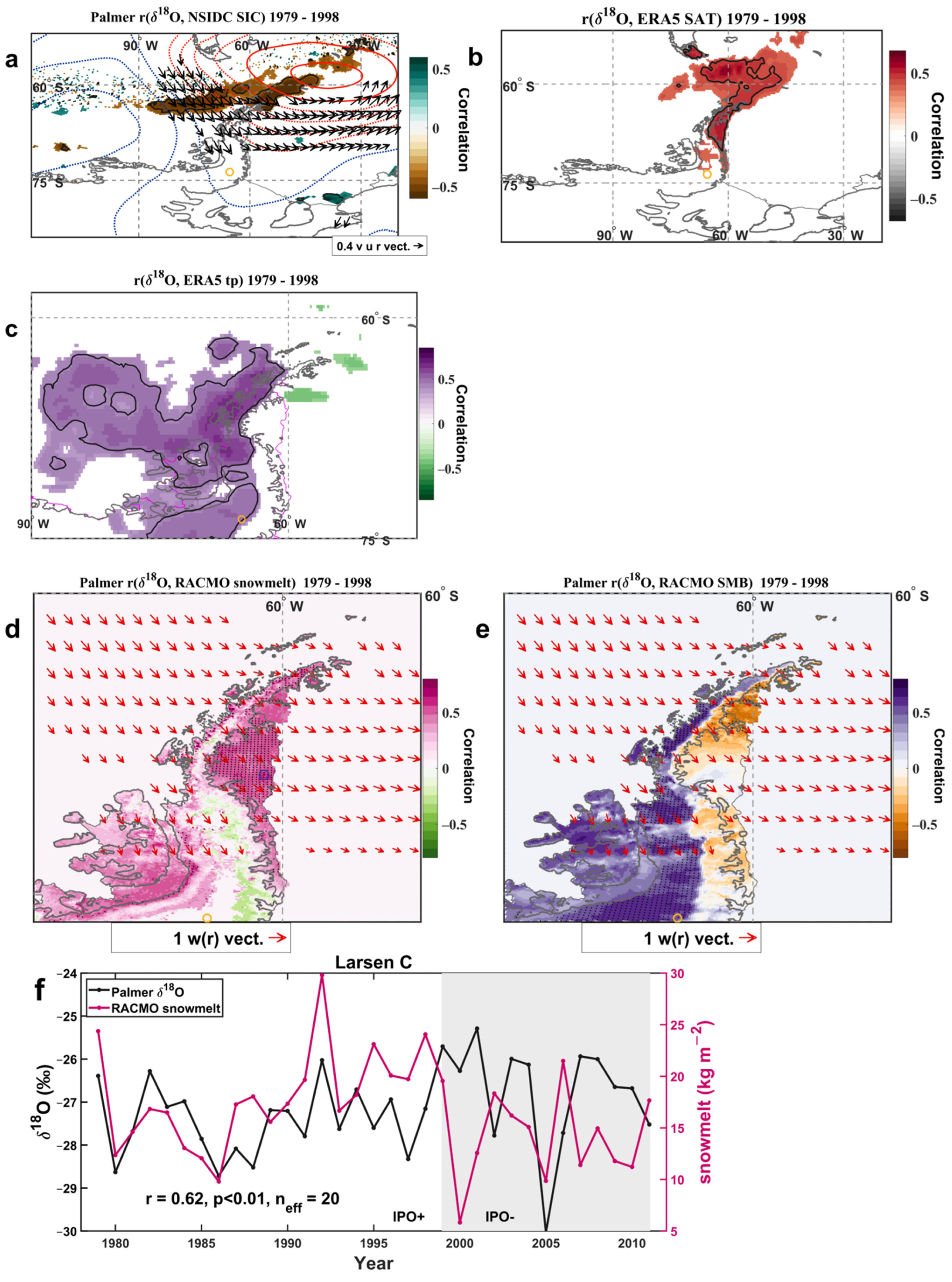
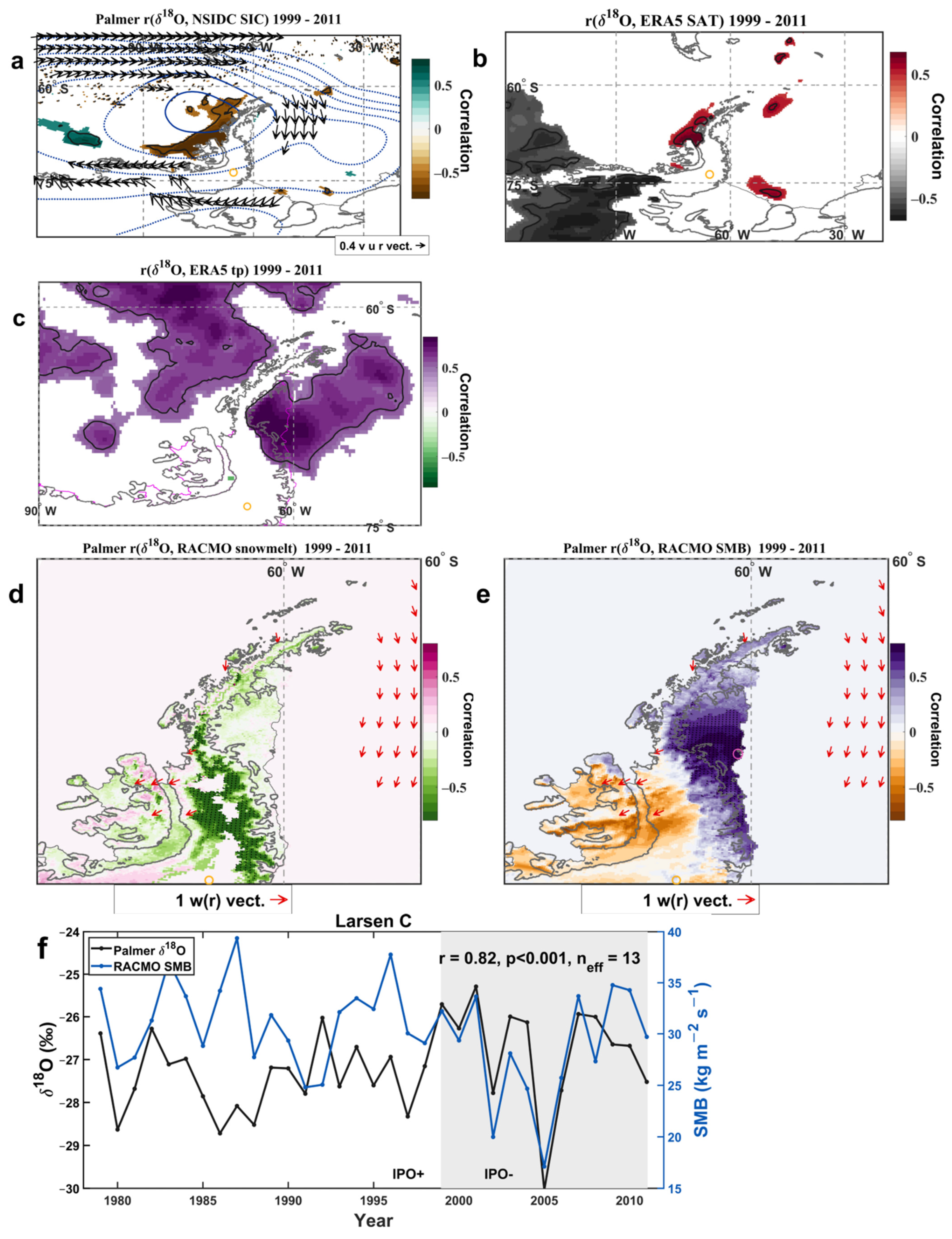
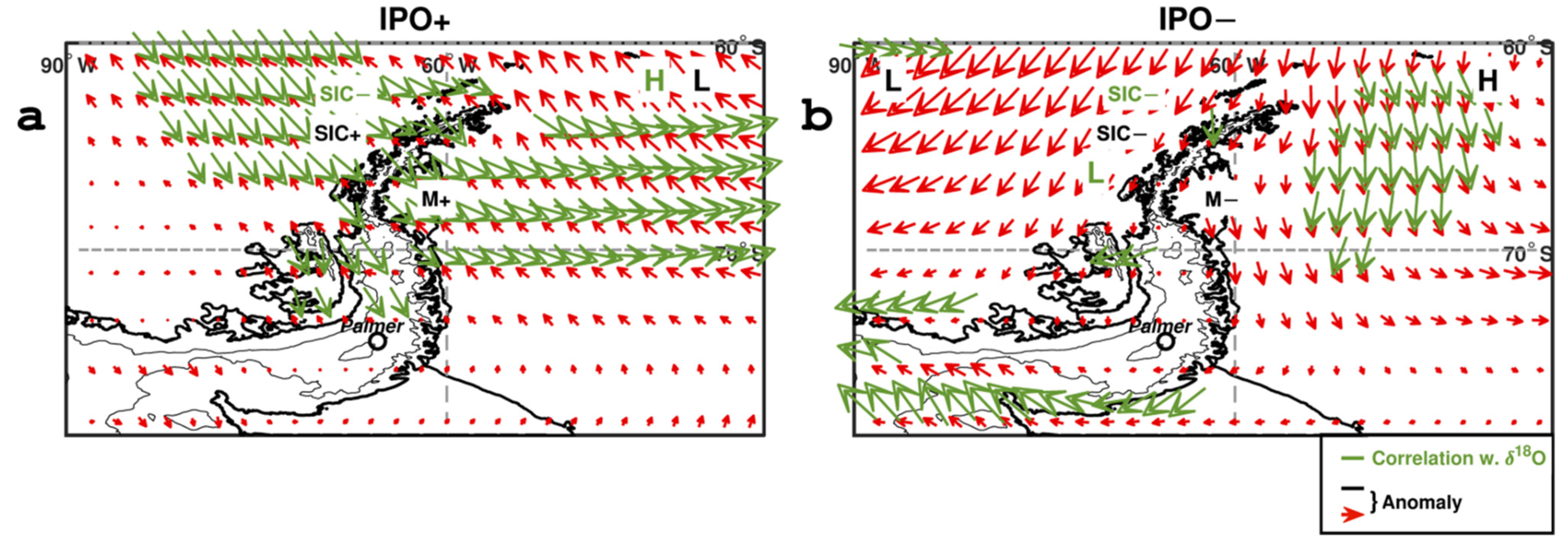
Publisher’s Note: MDPI stays neutral with regard to jurisdictional claims in published maps and institutional affiliations. |
© 2022 by the authors. Licensee MDPI, Basel, Switzerland. This article is an open access article distributed under the terms and conditions of the Creative Commons Attribution (CC BY) license (https://creativecommons.org/licenses/by/4.0/).
Share and Cite
Emanuelsson, B.D.; Thomas, E.R.; Humby, J.D.; Vladimirova, D.O. Decadal Scale Variability of Larsen Ice Shelf Melt Captured by Antarctic Peninsula Ice Core. Geosciences 2022, 12, 344. https://doi.org/10.3390/geosciences12090344
Emanuelsson BD, Thomas ER, Humby JD, Vladimirova DO. Decadal Scale Variability of Larsen Ice Shelf Melt Captured by Antarctic Peninsula Ice Core. Geosciences. 2022; 12(9):344. https://doi.org/10.3390/geosciences12090344
Chicago/Turabian StyleEmanuelsson, B. Daniel, Elizabeth R. Thomas, Jack D. Humby, and Diana O. Vladimirova. 2022. "Decadal Scale Variability of Larsen Ice Shelf Melt Captured by Antarctic Peninsula Ice Core" Geosciences 12, no. 9: 344. https://doi.org/10.3390/geosciences12090344
APA StyleEmanuelsson, B. D., Thomas, E. R., Humby, J. D., & Vladimirova, D. O. (2022). Decadal Scale Variability of Larsen Ice Shelf Melt Captured by Antarctic Peninsula Ice Core. Geosciences, 12(9), 344. https://doi.org/10.3390/geosciences12090344








